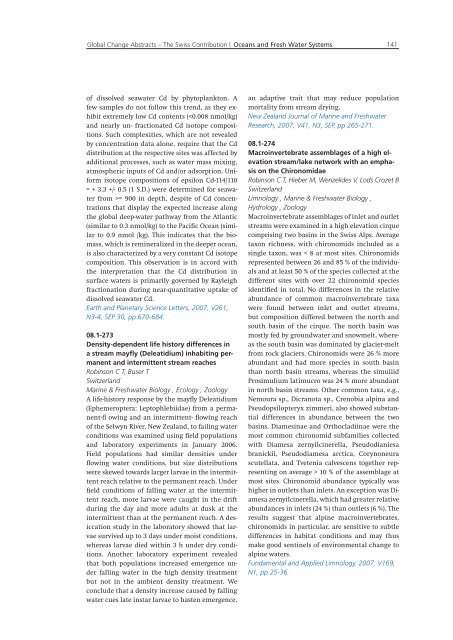Global Change Abstracts The Swiss Contribution - SCNAT
Global Change Abstracts The Swiss Contribution - SCNAT
Global Change Abstracts The Swiss Contribution - SCNAT
You also want an ePaper? Increase the reach of your titles
YUMPU automatically turns print PDFs into web optimized ePapers that Google loves.
<strong>Global</strong> <strong>Change</strong> <strong>Abstracts</strong> – <strong>The</strong> <strong>Swiss</strong> <strong>Contribution</strong> | Oceans and Fresh Water Systems<br />
of dissolved seawater Cd by phytoplankton. A<br />
few samples do not follow this trend, as they exhibit<br />
extremely low Cd contents (= 900 in depth, despite of Cd concentrations<br />
that display the expected increase along<br />
the global deep-water pathway from the Atlantic<br />
(similar to 0.3 nmol/kg) to the Pacific Ocean (similar<br />
to 0.9 nmol /kg). This indicates that the biomass,<br />
which is remineralized in the deeper ocean,<br />
is also characterized by a very constant Cd isotope<br />
composition. This observation is in accord with<br />
the interpretation that the Cd distribution in<br />
surface waters is primarily governed by Rayleigh<br />
fractionation during near-quantitative uptake of<br />
dissolved seawater Cd.<br />
Earth and Planetary Science Letters, 2007, V261,<br />
N3-4, SEP 30, pp 670-684.<br />
08.1-273<br />
Density-dependent life history differences in<br />
a stream mayfly (Deleatidium) inhabiting permanent<br />
and intermittent stream reaches<br />
Robinson C T, Buser T<br />
Switzerland<br />
Marine & Freshwater Biology , Ecology , Zoology<br />
A life-history response by the mayfly Deleatidium<br />
(Ephemeroptera: Leptophlebiidae) from a permanent-fl<br />
owing and an intermittent- flowing reach<br />
of the Selwyn River, New Zealand, to failing water<br />
conditions was examined using field populations<br />
and laboratory experiments in January 2006.<br />
Field populations had similar densities under<br />
flowing water conditions, but size distributions<br />
were skewed towards larger larvae in the intermittent<br />
reach relative to the permanent reach. Under<br />
field conditions of falling water at the intermittent<br />
reach, more larvae were caught in the drift<br />
during the day and more adults at dusk at the<br />
intermittent than at the permanent reach. A desiccation<br />
study in the laboratory showed that larvae<br />
survived up to 3 days under moist conditions,<br />
whereas larvae died within 3 h under dry conditions.<br />
Another laboratory experiment revealed<br />
that both populations increased emergence under<br />
falling water in the high density treatment<br />
but not in the ambient density treatment. We<br />
conclude that a density increase caused by falling<br />
water cues late instar larvae to hasten emergence,<br />
141<br />
an adaptive trait that may reduce population<br />
mortality from stream drying.<br />
New Zealand Journal of Marine and Freshwater<br />
Research, 2007, V41, N3, SEP, pp 265-271.<br />
08.1-274<br />
Macroinvertebrate assemblages of a high elevation<br />
stream/lake network with an emphasis<br />
on the Chironomidae<br />
Robinson C T, Hieber M, Wenzelides V, Lods Crozet B<br />
Switzerland<br />
Limnology , Marine & Freshwater Biology ,<br />
Hydrology , Zoology<br />
Macroinvertebrate assemblages of inlet and outlet<br />
streams were examined in a high elevation cirque<br />
comprising two basins in the <strong>Swiss</strong> Alps. Average<br />
taxon richness, with chironomids included as a<br />
single taxon, was < 8 at most sites. Chironomids<br />
represented between 26 and 85 % of the individuals<br />
and at least 50 % of the species collected at the<br />
different sites with over 22 chironomid species<br />
identified in total. No differences in the relative<br />
abundance of common macroinvertebrate taxa<br />
were found between inlet and outlet streams,<br />
but composition differed between the north and<br />
south basin of the cirque. <strong>The</strong> north basin was<br />
mostly fed by groundwater and snowmelt, whereas<br />
the south basin was dominated by glacier-melt<br />
from rock glaciers. Chironomids were 26 % more<br />
abundant and had more species in south basin<br />
than north basin streams, whereas the simuliid<br />
Prosimulium latimucro was 24 % more abundant<br />
in north basin streams. Other common taxa, e.g.,<br />
Nemoura sp., Dicranota sp., Crenobia alpina and<br />
Pseudopsilopteryx zimmeri, also showed substantial<br />
differences in abundance between the two<br />
basins. Diamesinae and Orthocladiinae were the<br />
most common chironomid subfamilies collected<br />
with Diamesa zernyilcinerella, Pseudodianiesa<br />
branickii, Pseudodiamesa arctica, Corynoneura<br />
scutellata, and Tvetenia calvescens together representing<br />
on average > 10 % of the assemblage at<br />
most sites. Chironomid abundance typically was<br />
higher in outlets than inlets. An exception was Diamesa<br />
zernyilcinerella, which had greater relative<br />
abundances in inlets (24 %) than outlets (6 %). <strong>The</strong><br />
results suggest that alpine macroinvertebrates,<br />
chironomids in particular, are sensitive to subtle<br />
differences in habitat conditions and may thus<br />
make good sentinels of environmental change to<br />
alpine waters.<br />
Fundamental and Applied Limnology, 2007, V169,<br />
N1, pp 25-36.

















